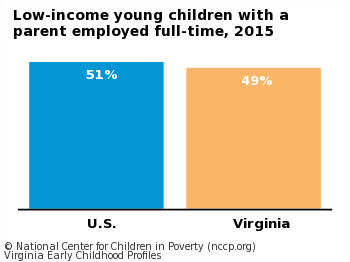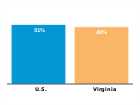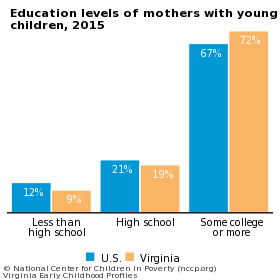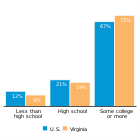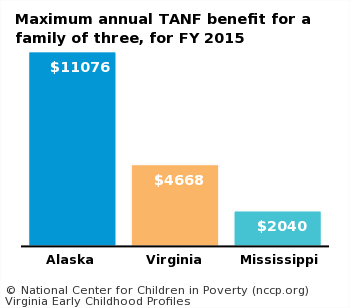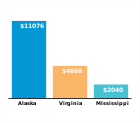State Choices to Promote Effective Parenting
- Extends Medicaid coverage for family planning to otherwise ineligible low-income women [2018]2
Eligibility based on income up to 205% FPL, includes men and individuals younger than 19 years of age. The state also extends eligibility for women losing coverage postpartum. - Exempts single parents on TANF from work requirements until the youngest child reaches age 1 [FY 2016]3
The exemption is limited to 12 cumulative months in the recipient's lifetime. The caretaker can be exempt for a maximum of 6 additional weeks if s/he has another child after the limit expires. Recipients caring for a child subject to a family cap are only exempt while the child is under 6 weeks old. For parents that are in Virginia's VIEW, they are automatically exempt from activities requirements. - Reduces the TANF work requirement to 20 hours or less for single parents with children under age 6 [FY 2016]3
Recipients who are in Virginia's VIEW Program are required to work 30 hours per week if employed full time. All other recipients are not required to participate in work activities.
State Choices to Promote Family Economic Security
- Established a state minimum wage that meets or exceeds $9.10/hr and is indexed to inflation [2016]4
$7.25 - Exempts single-parent families of three below the federal poverty level from personal income tax [2016]5
- Offers a refundable state Earned Income Tax Credit [2017]6
- Offers a refundable state dependent care tax credit [FY 2016]7
Under Virginia Tax Deduction for Child and Dependent Care Expenses, the maximum nonrefundable credit is $345. - Keeps copayments for child care subsidies below 10% of family income for families of three at 150% FPL [2015]8
- Offers exemptions and/or extensions of the TANF benefit time limit for women who are pregnant or caring for a child under age 6 [FY 2016]3
All individuals except for those in the VIEW program are exempt from time limits. Pregnant women that participate in the VIEW program are not exempt from time limits. - Has paid family leave for a minimum of 6 weeks with partial replacement of wages [2018]9
Data Notes and Sources
Last Updated: May 13, 2015
Send us recent developments to update your state's profile.
- National data were calculated from the 2011 American Community Survey, representing information from 2011. State data were calculated from the 2009-2011 American Community Survey, representing information from the years 2009 to 2011.
- Guttmacher Institute. (2018). Medicaid Family Planning Eligibility Expansions. New York, NY: Guttmacher Institute. Https://www.guttmacher.org (accessed January 3, 2018).
- Giannarelli, L., Heffernan, C., Minton, S., Thompson, M., & Stevens, K. (2017). Welfare Rules Databook: State TANF Policies as of July 2016. OPRE Report 2017-82. Washington, DC: Office of Planning, Research, and Evaluation, Administration for Children and Families, U.S. Department of Health and Human Services. https://www.acf.hhs.gov (accessed December 19, 2017).
- National Conference of State Legislatures. 2016. State minimum wages: 2016 minimum wages by state. Washington, DC: NCSL. Http://www.ncsl.org (accessed February 18, 2016).
- National Center for Children in Poverty (NCCP), 50-State Policy Tracker. (2016). 50-State Data, Income Tax Liability. http://nccp.org (accessed July 20, 2018).
- Williams, E., & Waxman, S. (2018). States Can Adopt or Expand Earned Income Tax Credits to Build a Stronger Future Economy. Washington, DC: Center on Budget and Policy Priorities. https://www.cbpp.org (accessed June 29, 2018).
- National Women's Law Center. (2017). State Child Care and Dependent Care, Tax Provisions, Tax Year 2016. Washington, DC: National Women's Law Center. https://nwlc.org (accessed December 19, 2017).
- Schulman, Karen; Blank, Helen. 2015. Building Blocks State Child Care Assistance Policies 2015. National Women's Law Center. Http://www.nwlc.org (accessed November 11, 2015).
- National Conference of State Legislatures. (2018). State Family Medical Leave and Parental Leave Laws. Washington, DC: National Conference of State Legislatures. http://www.ncsl.org (accessed July 20, 2018).


